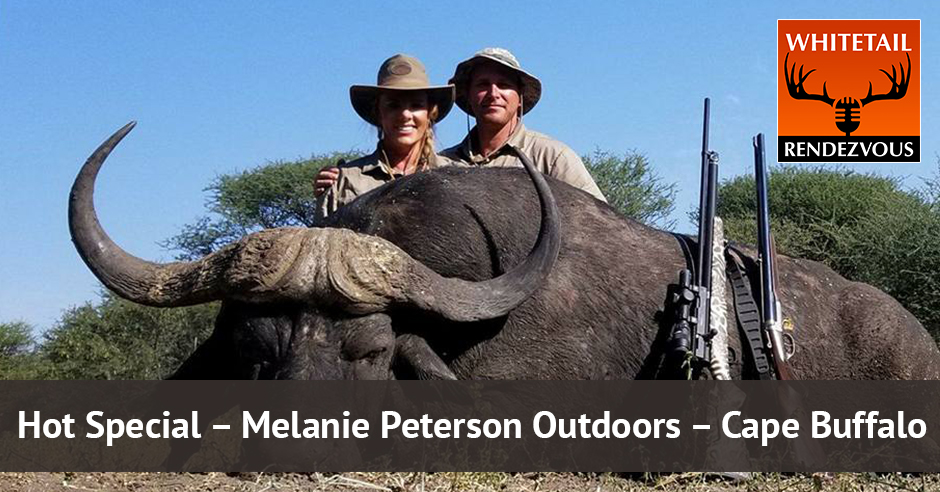
listen to the podcast here
Hot Special – Melanie Peterson Outdoors – Cape Buffalo
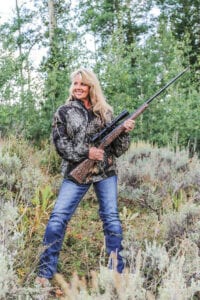 We’re going to go to South Africa with David Freeburn of Dave Freeburn Safaris. We are going to join Melanie Peterson in a park in Pinedale, Wyoming. We’re heading over to Oregon since I’m in Colorado with Marc LeQuieu. We have a unique story to share because Melanie is going to first share about winning the Extreme Huntress contest of 2018 and then it’s going to lead to a conversation she had with Dave. They had ended up in Cape Town or Johannesburg and then she hunted in South Africa for Cape buffalo with an air rifle. Melanie, Marc and Dave, welcome to the show.
We’re going to go to South Africa with David Freeburn of Dave Freeburn Safaris. We are going to join Melanie Peterson in a park in Pinedale, Wyoming. We’re heading over to Oregon since I’m in Colorado with Marc LeQuieu. We have a unique story to share because Melanie is going to first share about winning the Extreme Huntress contest of 2018 and then it’s going to lead to a conversation she had with Dave. They had ended up in Cape Town or Johannesburg and then she hunted in South Africa for Cape buffalo with an air rifle. Melanie, Marc and Dave, welcome to the show.
Thank you, Bruce.
You’re up Melanie.
I won the Extreme Huntress competition for the 2018 season. It’s getting underway to select the 2019 winner here. I wanted to do something with the title that made a difference and some impact. I met both of these crazy guys over the course of my journey at various SCI shows. I am visiting with Dave. I decided I wanted to shoot a Cape buffalo with an air rifle, which has never been done before. I got the raised-eyebrow look for a little while. He required us to prove to him that it could be done. To be quite honest, I haven’t picked up an air rifle in probably 25 years and it was a BB gun. They’re not your father’s BB guns anymore. They’re big-bore air rifles, serious weapons. I do a lot of testing and a lot of hard work on my outfitter’s part. Dave was able to secure a permit from South Africa and off we went.
Dave, what did you think when Melanie came up to you and suggested this at Dallas Safari Club?
She’s a very convincing lady. We had a chat about it and I didn’t think she was very serious in the beginning. She came past the booth the next day and said this is something she wants to do. I said, “I had to check the legality on everything and as long as it was legal and we could secure a permit, it was all guns blazing.” I did have some reservations of the penetration, the distance we needed to be within close range proximity of the buffalo. With buffalo hunting, it’s usually close quarters anyway. Putting all those facts together, it was something that intrigued me but I did have some reservation. She did have to prove a little bit. Marc developed the bullet. Once they sent me all the literature regarding what I needed to secure the permit, it was something to look forward to and to do something that no one else has done.
Before we get into the hunt, Marc, let’s go back on the technical side of it because everybody thinks of a Daisy air rifle or a Crosman air rifle. You’re going after a buffalo which weighs 1,800 pounds or so and is part of the big five.
An air-driven rifle with energy levels about 750-foot pounds of energy can be the ticket for getting your target down the ground. Share on XThey’re mean as hell. There’s the old saying that when a buffalo hits the ground, he’s angry. It’s not an animal that most people think of hunting their first animal in Africa, that’s for sure.
This process is one of those things that we didn’t take lightly. When Melanie talked to me at the SCI show about what she was going through to set this up and how she had it programmed in her mind of what she wanted to happen. She’s not hunting it from a ground blind but getting out on the ground with the animals, doing the spot and stalk. I knew she was serious about what she was talking about because she’d already done a lot of the background homework even by the time I spoke to her, which could have been maybe a couple of weeks after Dave and Melanie tied in together. When she brought the idea to me, we had the discussion about what type of air rifle, how we were going to do this, the technology, where it’s come and what we were looking for energy-wise. I didn’t feel that there was a bullet on the market that was designed to do this, a low-velocity, dangerous game round for even pistols and muzzleloaders. I didn’t feel like anybody had addressed that issue.
When she talked to me, it seemed like a perfect release for an idea that I had drawn up for many years, but there’s no real reason to develop it. When she said she was going to kill a Cape buffalo with an air rifle, I knew the velocity would be around 1,000 feet per second. I knew, with my past being a professional hunter, what it would take to kill a buffalo with a projectile that was moving at that velocity. We went ahead and developed what we call the warhead bullet, which is a break from traditional bullet designs. It has a lead jacket and a solid core. Instead of your traditional bullet being a jacketed soft point with a copper jacket and a lead core, we’ve moved things around and we’ve gone lead on the outside to engrave the rifling at low velocities and to maintain that speed that we want.
We went with a brass core for the round and we hot-pour the lead around that. That gives us a bullet that’s somewhat homogeneous in its behavior, but it maintains a very sharp cutting ring around the nose. As we machine the cores, we build in a ring in the frontend that will cut and keep a wound channel open. I knew that we needed that because animals in Africa have an innate ability to shut down large arterial bleeds in different ways by constricting those. We needed a permanent wound channel that would allow that animal to expire quickly and efficiently.
Plus, they’re heavier boned.
There is testing required. I’ve never hunted in South Africa before. This was my very first trip and I’ve never seen a Cape buffalo before. I was asking lots of questions to Dave, I’m like, “What kind of penetration do we need to get? How thick is the skin? How thick is the bone structure?” We set up a mock buffalo hunt in my backyard in Texas. I went down to Tandy Leather and I got several pieces of quarter-inch-thick hide. We created a two-inch-thick skin on top of a three-quarter-inch plywood Cape buffalo. We backed it with two inches of solid oak and then we shot through sixteen inches of ballistic gel. We set up at 50 yards, which was always going to be our target distance just to see what these bullets would do. It not only went clean through everything, but it also shot out the back of the sixteen inches of ballistic gel.
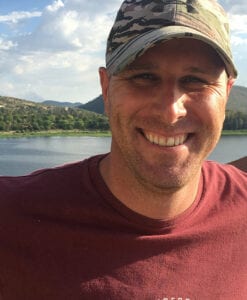 It blew out the ballistic gel. Is that what you’re telling me?
It blew out the ballistic gel. Is that what you’re telling me?
Yes, all the way through.
How big was the wound channel?
The wound channel is more of a projectile. The bullet itself is .457.
The wound channel that is permanently created, you can see the ring there. Next to that little tip that protrudes, there’s a ring right on edge. We machine that into the brass cores so that it is the diameter of a permanent slug that comes out of the animal. As that goes through the first layer of hide, bone and whatnot, it disrupts and cuts at least that out of the way. This is just a core. This doesn’t have the lead around the core that we would have on a finished product, but this is what creates the permanency in the wound channel. It’s that little simple ring right there. That’s what allows the fat to not congeal or the tissue to not shrink back up. On a round-nose bullet, the bullet pushes through and the tissue immediately closes around behind it. We wanted to make sure that it was a permanent hole that we created. That’s the core of the warhead bullet right there.
You said around 1,000 feet per second at the most.
Our target goal was 950 feet per second. We had Terry Tate from Professional Big Bore Airguns build us a rifle. He’s had 25 years of experience in the airgun industry building, tinkering and hobbying. It’s a passion of his. When we discovered him with the other seven custom makers that we looked at, the simplicity of his rifle allows for international travel a lot easier than some other gas guns. His gun is a very simple mechanism. He has a bolt-action loading port that you would recognize from a traditional bolt-action rifle. He has a cocking lever on the other side which charges the hammer. This is what compresses the spring and the hammer goes forward and allows the gas port to open so that gas comes in behind the round and down the chamber.
As your velocity goes up, your energy level goes up dramatically. Share on XThese air rifles are not what we would typically find in any store. They’re not expensive for custom guns. Terry’s guns start at between $1,500 and $1,800. Melanie is going to be having a Melanie Peterson line of rifles to our specification for people to hunt internationally with. You can prime this gun with a hand pump. You do not have to take all the other accoutrements that go with the typical big-bore air rifle. This was a learning process for Melanie, myself and Dave. We took a lot of extra gear in the advent that we needed it. We took compressors, bottles, tanks, lines and everything. What we’ve come down to after this experience is the ability to feel a rifle and a hand pump that a person can take into the field and go international with a gun case. It’s so much simpler to do it this way than to pack all the other items that you might need. That’s why Terry’s gun was our choice. It fits our bill for simplicity and power.
You have no idea how bad I want to insert the little videotape of Dave air pumping that rifle up to 4,000 PSI.
It takes about 75 to 100 good strokes on that hand pump to get this up to 45. You can see his rifles have a little air gauge. The air chamber is the lower of the two cylinders, with the barrel being free-floated up above. Melanie has a great camo pattern that I was a little dubious until I saw it. This camo pattern is a take-off of a leopard print and what appears to be a zebra combo. It is perfect for hunting in Africa. It was shocking. I was like, “That’s not going to work,” and it works perfectly.
Did you create that pattern, Melanie?
Yes, I did. I’m ashamed to say that I took pictures of clothing that I had in my closet.
If you set this down in the bush, you won’t find it again. It disappears. It’s quite handsome, the way it turned out. I love it. The .457 Professional Big Bore rifle from Terry Tate is the gun we used. You can see he’s a phenomenal craftsman. His fit and finish are exceptional. We’ve been working with him in hopes that he will produce a double rifle that he has been working on for the last few years. We’re looking forward to pushing him into the future with a new double dangerous game air rifle.
Let’s get back to the hunt. Dave, when Melanie shows up, how does she do on the range when she sights in after getting off the jet and you’ve seen the videos and everything, but now it’s go-time? How did she do from the get-go?
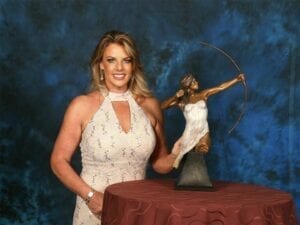 Taking the rifle to the range, I’m very skeptical. I still hadn’t seen the finished product in the field. Once everything was pumped up and ready to go and we got the gun sighted in on the range, I was very impressed with the impact that we could see on the actual target at about 50 yards. It gave me a lot of confidence. Her accuracy sighting in the gun also gave me a lot of confidence. Her willingness to take instruction when needed was putting the package together. A good package, that we would be safe doing this buffalo hunt was also a concern. Having Marc in the background, also the second PH, knowing that we’ve got two camera crews, Melanie, trackers and myself, safety was key. We didn’t go into the bush blindly thinking that this was all going to be easy. Once the gun and Melanie sighting in and everything was to my satisfaction, we headed off into the field to see if we could find ourselves a Cape buffalo.
Taking the rifle to the range, I’m very skeptical. I still hadn’t seen the finished product in the field. Once everything was pumped up and ready to go and we got the gun sighted in on the range, I was very impressed with the impact that we could see on the actual target at about 50 yards. It gave me a lot of confidence. Her accuracy sighting in the gun also gave me a lot of confidence. Her willingness to take instruction when needed was putting the package together. A good package, that we would be safe doing this buffalo hunt was also a concern. Having Marc in the background, also the second PH, knowing that we’ve got two camera crews, Melanie, trackers and myself, safety was key. We didn’t go into the bush blindly thinking that this was all going to be easy. Once the gun and Melanie sighting in and everything was to my satisfaction, we headed off into the field to see if we could find ourselves a Cape buffalo.
Tell me about the first mock stalk, if you will.
The first idea was to shoot maybe smaller species like a blue wildebeest or an impala to get ourselves accustomed to the stalk with eight people in the bush. Being in Africa and very unpredictable, on our very first morning at 8:00, we bumped to a herd of about seventeen to eighteen bull. Glassing the herd, I could see with the tracker, as well and Marc’s help, that we had possibly good shooter bulls in there. They were leading the herd heading towards us. I don’t know what happened, the wind changed or something happened, but the herd started running towards us. Something spooked them. That was about 200 yards. I said to Melanie, “This is going to happen a lot quicker than I thought it would.” The herd ran towards us. The younger bulls split off to the right and we had the two dominant or main bulls come charging up the road.
They weren’t paying much attention to the two-track that we had snuck down either. They had come crashing through the bushes. The terrain that we were dealing with, just to give you a little bit of a picture. In South Africa, they had a huge rain season and it was late. The bush was as thick as I had ever seen it in twenty-plus years of doing this. I had never seen the bush as healthy and as vibrant as when we were there. These things are coming through this thorn thicket material. We’re sneaking down an open two-track area that had been overgrown and here these things are moving through the bush. It’s not like they were giving Melanie any grace. They were coming through a thorn thicket that we had to go through later on as we were doing some tracking. It would take people, a few minutes to get around some of these thickets. These bulls were pushing through it. They were intent on getting as close to us as possible, which was exciting.
They are very close.
Define very close.
What happened is that while they were coming through the thicket snorting and bellowing, the black brush there as we call it, you can see through the bush, but you can’t see what’s going on there. You could see the outline of the buffalo, but it was maybe ten to fifteen yards at the most these bulls stopped and kept on snorting at us. I had Melanie up on the sticks at this stage, Marc was to the left of me and I was on the right trying to see which bull would be the better one to shoot. I said to her, “You better get ready. If something is going to happen, it’s going to happen at fifteen yards.”
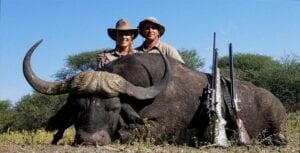 Dave was sitting there on his backside with binoculars up and his double is braced against him. We all try to keep our guns close in events like this. As PH, you never give your gun to somebody, you never hand it to another person. It’s always right there. Melanie turns and she looks back at me over her left shoulder, and then she looks over at Dave and she looks back at me like, “Why doesn’t he have his gun in his hands?” I was sitting there chuckling to myself because we do take it for granted. As professional hunters we see these things play out more times than our clients. Melanie was like, “Tell him to get his gun up.” Dave is picking out a trophy. That’s what we do. Our focus is trying to pick out the best scenario.
Dave was sitting there on his backside with binoculars up and his double is braced against him. We all try to keep our guns close in events like this. As PH, you never give your gun to somebody, you never hand it to another person. It’s always right there. Melanie turns and she looks back at me over her left shoulder, and then she looks over at Dave and she looks back at me like, “Why doesn’t he have his gun in his hands?” I was sitting there chuckling to myself because we do take it for granted. As professional hunters we see these things play out more times than our clients. Melanie was like, “Tell him to get his gun up.” Dave is picking out a trophy. That’s what we do. Our focus is trying to pick out the best scenario.
That was the PG version of what I said.
I was trying to be politically correct.
He was trying to be kind.
She might have said some things to Dave that was a little more motivational, but Dave was as calm as he could be. He’s like, “If he steps out, you’re going to have to shoot him.” At that point, ten yards away, there wasn’t going to be a choice. If this bull had chosen to come around the last remaining few vestiges of vegetation, Melanie would have had to shoot him. I mean that’s how you have to start. You can’t script some of these things. No matter how good Dave is, he can’t make bulls do exactly what he wants them to do.
There’s a 1,800-pound bull ten yards away. We have an air rifle that’s been tricked out and quite capable of doing the job. Marc, what did you have in your hand as a PH on the left side?
Being that I was one of the last Americans in Botswana to get my professional hunting license, I used to carry and it was very indicative of me with my clients, an 1886 .45-90 lever-action rifle. That was and has been my backup rifle. I took the old girl out of retirement and brought her back into South Africa. I shoot a 450-grain bullet at around 2,000 feet per second. It doesn’t quite compare to Dave’s .500 Nitro. Dave’s .500 is one of those, “Pick an animal up and throw it to the ground” guns. Mine is more of a, “Stop right there, try not to come any closer” guns. It was a good combination to have.
We could get to 50 or 60 yards and still be comfortable enough to make sure that we can shoot this buffalo humanely and safely. Share on XThat .500 Nitro is the sexiest rifle on the planet.
Verney-Carron is giving Holland & Holland a real run for their money. Verney does great work and that .500 balances perfectly. It’s a nice gun. That company puts together some good products that we appreciate. The innate beauty of the wood to metal fit finish and how he balances the weapons is impressive.
For the people that don’t know, Dave, tell the audience who shoot .30-06s or .30-30s at whitetails that weigh maybe 200 pounds more or less. Tell us about the sexy side-by-side.
Every professional hunter dreams to carry a double rifle. It took a few years to save up some money and I got this gun custom made by Verney-Carron about four years ago. It has a special engraving and a perfect fit for me. The original caliber that I wanted was a .470 but being a man and a little persuasion from the gun company themselves, I upgraded to a .500 Nitro Express.
That’s a 500-grain bullet, is that correct?
It’s 565 grains that Dave drives or 575. It’s about as heavy as they go. It drives them at about 2,200 feet per second. We were shooting an air rifle to bring this back around with a 385-grain bullet at around 950 feet per second. It’s about half of what the .500 does, comparably speaking, but the energy levels and how you deal with airguns. Airguns, we don’t operate their power levels based off of feet per second. They calculate it based on the foot-pounds of energy. What we’re looking for in big game rifles that are air-driven are energy levels above 750 foot-pounds of energy. That seems to be the ticket for breaking bones, deep penetration and getting moose, elk, bison, buffalo, bear down on the ground effectively.
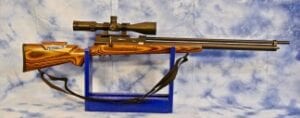 When your bullet hits, what’s it hitting the Cape buffalo or any animal, Dave?
When your bullet hits, what’s it hitting the Cape buffalo or any animal, Dave?
Dave’s .500 produces around 5,000 foot-pounds of energy. You can see that correlation, as your velocity goes up, your energy level goes up dramatically. At 1,000 foot-pounds a similar bullet from an air rifle is only producing about a fifth or so of the power. The nice thing about Dave’s .500 is that security. At a touching distance, which is what professional hunters typically wait for, we don’t like shooting our own guns because they’re expensive. At touching distances, his .500 is one of those things that slams animals to the ground. That’s what a proper backup rifle needs to do.
He let me shoot his rifle once. I shot it twice, but one was enough. I have a video. That thing nearly knocked me over.
The .500 will physically make you take a step backwards unless you’re used to shooting it. It’s one of those things where you do have to catch it. It’s coming to you. That rifle at fifteen pounds is still motivating you to move your body in a rearward direction.
Melanie, let’s talk about your picture with your buffalo. What’s the sensation there? We did a part one segment about the why of hunting. What are you thinking about? You’ve been around hunting all your life with an outfitting camp in Wyoming and now you’re with one of the big five.
The moments probably after this picture was taken, I had tears because it was a moment that there was a culmination of all of the planning, the testing and the, “Are we going to get a permit? Are we not going to get a permit? Is this going to work? Is it not going to work?” It was such an emotional sense of relief that I was teary in the picture.
I’m looking at that. You read Chadwick or Ruark or some of the people that went to Africa, back in the day of tents. You think about that and then Melanie put herself back in time, but she brought technology with her. That’s what that picture speaks to me. It’s a lady that went back in time to do the hunt but brought the technology of this day. I’m going to segue into their new business, Melanie Peterson Outdoors. How does this all work? Melanie, share with us about Melanie Peterson Outdoors.
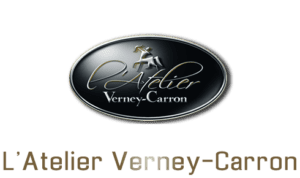 I’ve been a guide for 25 years, but after I won the Extreme Huntress title, I wanted to do something extraordinary. I wanted to do something that was going to promote not only women in the industry, but I also wanted to give hunting a fast-forward. When I started looking into these airguns, I thought, “Little tiny kids, seven, eight, nine years old, they can carry these airguns. What a fantastic opportunity to introduce somebody to this sport that we all love so much with a seemingly harmless air rifle.” It is almost like a baby step into what we’re hoping is going to be a lifelong passion for these people.
I’ve been a guide for 25 years, but after I won the Extreme Huntress title, I wanted to do something extraordinary. I wanted to do something that was going to promote not only women in the industry, but I also wanted to give hunting a fast-forward. When I started looking into these airguns, I thought, “Little tiny kids, seven, eight, nine years old, they can carry these airguns. What a fantastic opportunity to introduce somebody to this sport that we all love so much with a seemingly harmless air rifle.” It is almost like a baby step into what we’re hoping is going to be a lifelong passion for these people.
I wanted to make a difference. Doing this, I’ve heard, “It’s a publicity stunt. It was all for show and there was no purpose behind it.” I wanted it to be with purpose and I wanted it to be ethical. If anybody knew the countless hours that all of us spent proving that this can be down before a shot was ever fired at an animal, they would see that it wasn’t something that was done haphazardly and a stupid idea. There were moments in my hunt that I thought this was a stupid idea. You’re talking about unproven technology there. I’m not going to lie, I was scared. The emotional release when it was done and it was successful. The weapon performed exactly the way it should and the animal died humanely. I feel that it was a success all around. I’m hoping that this kick-starts a whole new generation of hunters.
Dave, your thoughts as a PH and as an outfitter?
First off, to do this and think about it and Melanie did it, that’s the main thing for me as an outfitter, to make sure we all walked away from this. Shooting buffalo, I’ve got no reservations in terms of shooting any plain games with a big-bore rifle like that. It’s sufficient. The key to this whole success story was the planning and the hours that we put into this and the coming together, myself, Marc and Melanie proved to be the winning team. What can I say about the rifle? The rifle impressed me. It met my expectations and more. There’s a future for it. I think the more people we can expose to big-bore air rifle hunting, the better and the bigger it will get.
Marc, why don’t you come back and join us as part of Melanie Peterson Outdoors and give us your two cents?
I had some of those same reservations. Melanie and I talked, Dave and I talked. We built a bullet, the gun worked perfectly. Everything was what I was hoping for on this hunt. I do believe that there is a place for this, especially for people who like the challenges of bowhunting, the closeness that you have to be. They might not be able to do that with a traditional bow because of the weight restrictions drawing those things. Crossbows have unique limitations as well. This technology does allow a unique opportunity for people to pursue. I’m impressed by it. I’ve been following this technology for several years and we’re at a point where it’s going to go mainstream. This is going to be big.
Like you say, Marc, the technology there is not like a bow. We didn’t sit at a waterhole or over bait or anything like that. This was a traditional walk and stalk buffalo hunt. That was the main key that intrigued me is we could get to 50 or 60 yards and still be comfortable enough to make sure that we can shoot this buffalo humanely and safely. I don’t want to compare it exactly to bowhunting but there is a similarity. It’s something that I wish we could get those guns over here and I think there’s a big market in South Africa and Africa for these big-bore air rifles.
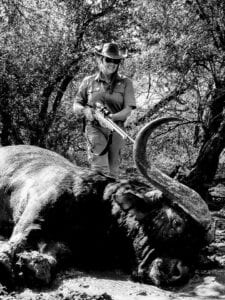 Dave, you said that you had to get a permit. You had to go through the whole process in South Africa to take it with that rifle.
Dave, you said that you had to get a permit. You had to go through the whole process in South Africa to take it with that rifle.
The first concern was to get a rifle permit. Traveling, Marc had a lot of admin on the British Airways side. I had a lot of admin on the South African imports here to make sure that when these guys arrive with all this gun that’s got valves, guppy tanks and compressors and that they don’t think we’re bringing in the next World War here. That was the first hurdle that we had to get through, which wasn’t as difficult as we thought it would be. We brought it in and the rifle permits were approved. The second was making sure that Nature Conservation was happy with the penetration, the foot-pound energy, the muzzle velocity, as well as the grain on the bullet, all fall in line with what the norms and standards for the Nature Conservation side.
Melanie, where do you go from here? What’s the next challenge?
We’re looking at perfecting this air rifle. I’m not going to say that there weren’t a few hiccups along the way, dealing with air. We’re trying to open some doors to be able to bring air rifles and have air rifles over in South Africa so that we don’t have to travel back and forth with them. There’s a whole new world of technology available too. We need to work on scopes. We need to work on some more ammunitions. There are a lot of doors that can be opened with this brand new segment to the hunting industry. We’ve got crossbows, we’ve got compound bows, we’ve got long-range rifles and now we’ve got big-bore air rifles.
I’m sitting here and especially for women, I don’t want to shoot a .500 Nitro. My .375 Ruger is fun enough. You think about that, the sound goes away. You don’t have a kick and you have some escaping gases, but there are no bangs because there’s no explosion. What a wonderful journey you’re on. Tell people how to get in touch with you, reach out to you or send an email. How do you want people to reach out to you?
I have a Facebook page, Melanie Peterson Outdoors. You’ll get to see the video of my hunt. We will showcase that on Melanie Peterson Outdoors first. You’ll get to see the play-by-play and you’ll get to feel the excitement as we’ve told you about here on this show. Dave, why don’t you go ahead and tell everybody how to get ahold of you to book a hunt?
I’m on Facebook and Instagram. My web page is DaveFreeburn.com.
Marc and I are at Melanie Peterson Outdoors and we do have a website that will be up as well.
Our primary source of communication is through social media because we’re doing our experiment on seeing how well social media promotes in and of itself. That’s the best way to contact us is through messaging. You can easily get ahold of us. We respond within less than 24 hours most of the time for any questions that people have. We have collaborations with Lethal Air and some of the other guys that I’m going to talk to Dave a little bit about in the near future. We’re trying to get some collaboration so that we have a mixed bag of air rifles to select from over in South Africa for not only our clients but for other clients that want to hunt with Dave. To make sure that he has access to some of the best equipment that’s geared up to do exactly what needs to be done over there.
Dave is working closely with another gentleman. He’s an outfitter there also, Choice Africa. They’re trying to change some legislation within South Africa to expand our opportunities. My dream is to have all of the big five with an air rifle.
I hope you will be given the opportunity. I look forward to you reporting and showing those hunts and possibly joining you over there on one of those hunts. That would be a neat thing for me. That’s for sure. Do you have any last words?
We just need to make sure we get you behind one of these guns very soon.
Dave?
Thanks for the opportunity. Bruce, like everyone says, “Once you’re behind that gun, Africa is waiting.”
Yes, it is. Melanie?
Thank you so much for having me, Bruce. You’ve been supportive of me through this entire process and I appreciate your support for the Extreme Huntress. I look forward to working with you for years to come.
This has been a little bit different show. This is the future of hunting and there are people out there that are innovating on all aspects of our hunting community. With women being the fastest growing statement in the hunting community, it’s people like Melanie, Marc and Dave that are opening up chapters that a few years ago or maybe months ago weren’t available for women.
Important Links:
- Dave Freeburn Safaris
- Melanie Peterson
- Marc LeQuieu
- Professional Big Bore Airguns
- Melanie Peterson Outdoors – Facebook
- DaveFreeburn.com
- Lethal Air
- Facebook – Dave Freeburn Safaris
- Instagram – Dave Freeburn Safaris
